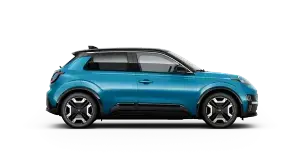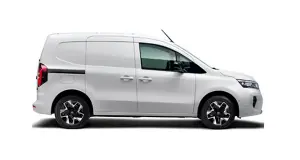Nissan LEAF 2023 Owners Manual
9.22.9. ProPILOT Park Precautions

Never attempt to drive while looking only at the screen.
There is the risk of hitting an obstacle or causing an unexpected accident.
Pay attention to the movement of vehicles and persons in the surrounding area.
Parking support is provided by making effective use of the detected path. Pay attention to the movements of oncoming vehicles, following vehicles, and pedestrians when operating parking control.
Car stops cannot be detected and there is some possibility that kerbs cannot be detected.
Depress the brake pedal to stop the vehicle if the wheels appear to hit a kerb or the vehicle appears to pass over a car stop. There is the risk of damage to the vehicle.
When parking support by ProPILOT Park is no longer necessary, deactivate ProPILOT Park.
If ProPILOT Park remains activated, there is the risk of an unexpected accident.
Before exiting the vehicle, check that the electric parking brake is activated and that the shift position is in P (Park).
Before using ProPILOT Park, check directly to confirm that there is sufficient space around the vehicle for the steering cut backs and other parking operations to be performed.
Depending on the circumstances, noise from inside or outside the vehicle may prevent the driver from hearing the warning sound.
Do not use ProPILOT Park in the following circumstances:
In a location where the traffic is heavy with persons and vehicles
In a location where stopping or parking is prohibited
In a location that is too narrow for the vehicle to fit
In a location where parking is not possible due to a hole, ditch, etc.
In a location where the street width is narrow
On a steep slope
On a gravel, dirt, or unpaved road
On a slippery surface, such as snow or ice
On a road that is not flat due to inclination, steps, kerbs, wheel ruts, or other reasons
On a road where the asphalt has melted due to exposure to excessive heat
In a location where a road heater (heater for preventing the road surface from freezing) is installed in the parking area
In a mechanical parking area or location where there are obstacles in the parking spaces
When the vehicle is overloaded
When worn tyres, an emergency tyre, a spare tyre, or tyre chains are being used
When the tyre air pressure is not correct
When a towing hook or similar item is installed
When an object is attached that interferes with the camera’s field of view
When the camera images are difficult to see due to dirt, sunlight, shadows, or other reasons
When the outside mirror is not all the way open
When the cameras are not properly installed
When an item is installed on the bumper that interferes with the parking sensors’ (sonar) performance
When there is a dent or other irregularity in the bumper
When there is rain, snow, mud, or some other substance adhering to the parking sensors (sonar)
When the loaded vehicle is tilted due to carrying an extremely heavy load or carrying a load only on one side
Under conditions such as the following, the parking sensors (sonar) and cameras may be unable to detect an obstacle, and the parking position or steering cut-back positions may not be set correctly. If an obstacle is present, depress the brake pedal and stop the vehicle or perform other suitable driving operations.
Persons, animals, or other moving obstacles In particular, it may not be possible to detect a person due to the type of clothing they are wearing.
Short obstacles
Locations which are lower than the ground level, such as ditches or holes
Poles or other thin obstacles
Thin obstacles, such as wires, ropes, or chains
Obstacles of a wire frame nature, such as wire nets, fences or shopping trolleys
Obstacles that have sharp shapes
Pipes and other obstacles that are located on walls or similar structures
Obstacles located at high positions
Spongy objects, snow, or other obstacles with a soft surface that can absorb sound waves
Obstacles that are extremely close to the bumper
Obstacles that suddenly enter the parking sensor (sonar) detection range when the vehicle is turning
Obstacles that rapidly approach the vehicle
Obstacles located at the sides of the vehicle
Obstacles that are not parallel to the front and rear of the vehicle
When the parking sensors (sonar) are frozen, or there is rain, snow, ice, dirt, or some other substance adhering to them
When the vehicle is tilted largely
When in extremely hot or cold conditions
When driving on rough roads, hills, gravel roads, or grass
When there is a loud noise in the surrounding area
When there is a device generating ultrasound (including vehicles equipped with sensors (sonar)) in the surrounding area
When the vehicle gets wet with rain or water
When the surroundings are dark, such as at night, when in underground locations or in an above-ground parking garage
When parking space lines are not clearly visible due to bad weather (rain, snow, fog, dust, sand or snowstorms)
When the camera lens is clouded due to contact with water
When strong light from the sun or streetlights shines on the road
When the road surface is wet and shining, such as during or after rain, or when there are puddles on the road
When sunlight shines into the camera, such as in the morning or in the evening
When the camera lens is dirty or there are water drops adhering to it
When an object is attached that interferes with the camera field of view
Under conditions such as the following, the brakes may be applied or correct parking control may not be possible.
When there is rain, snow, ice, dirt, or some other substance adhering to the parking sensors (sonar)
When there is a loud noise in the surrounding area
When there is a device generating ultrasound (including vehicles equipped with sensors (sonar)) in the surrounding area
When there is thick grass in the surrounding area
When passing near a structure with bumps or depressions
When there is a structure (such as a wall, toll collection equipment, or parking area gate) located nearby to the side of the vehicle
When there is a step, projecting object, or drain cover on the road
When passing under a hanging flag, plastic curtain, or similar object
When there are clumps of snow around the vehicle
Under conditions such as the following, correct parking control to the set position may not be possible. As necessary, move the vehicle to a more suitable position.
When the road surface is not flat
When the vehicle is tilted due to carrying an extremely heavy load or carrying a load only on one side
Under conditions such as the following, it may be impossible or difficult to detect a parking position.
When the vehicle is too close to the parking space
In a parking area without parking space lines where the spaces are created with rope, blocks, or other means
When the parking space lines are not clearly visible due to fading or dirt
When the contrast between the road and parking space lines is low
When the parking space lines on the road are yellow or some other colour besides white
When the parking space is extremely narrow or wide
When the parking space lines are extremely short
When the parking space lines are extremely narrow or wide
When the parking space lines are not parallel in the camera image due to inclination of the parking area or some other reason
When the parking space lines are connected to diagonal lines or other markings
When the shadow of the vehicle, shade from trees, or other shadows are on the parking space lines
When there is a neighbouring vehicle or some other obstacle on the parking space lines
When there is an obstacle in the parking space
When the surroundings are dark, such as at night, when in underground locations or in an above-ground parking garage
When parking space lines are not clearly visible due to bad weather (rain, snow, fog, dust, sand or snowstorms)
When the camera lens is clouded due to contact with water
When the sun or streetlights are reflecting on the road
When strong light from the sun or streetlights shines on the road
When the road surface is wet and shining, such as during or after rain, or when there are puddles on the road
When sunlight shines into the camera, such as in the morning or in the evening
When the camera lens is dirty or there are water drops adhering to it
When an object is attached that interferes with the camera field of view
When there is a step, gutter, road painting, repainted line, or similar item
When there is accumulated snow or snow-melting agents
When the parking area is paved with stones or greenery
When there is a noise pattern image in the parking space on the screen
When letters or other characters are painted in the parking space
When the road colour and brightness are not even
When the vehicle is stopped inclined relative to the parking space
When the street width is narrow
When there is an obstacle in front of the vehicle
When there is rain, snow, ice, dirt, or some other substance adhering to the parking sensors (sonar)
When there is a loud noise in the surrounding area
When there is a device generating ultrasound (including vehicles equipped with sensor (sonar)) in the surrounding area
When there is thick grass in the surrounding area
When there is a step, projecting object, or drain cover on the road
When there are clumps of snow around the vehicle
Under conditions such as the following, the parking position may not be detected in the correct location.
When there is light that looks like parking space lines, the reflection of a building or other object, a step, gutter, road painting, repainted line, or similar items
When there are marks from road repairs, letters printed on the road, poles, or other obstacles
When the road surface is wet and shining, such as during or after rain, or when there are puddles on the road
When the road colour and brightness are not even
When the parking area is on a slope
When a side step of the vehicle or a shadow is on the parking space line
When the parking space lines are not clearly visible due to fading or dirt
When the system is affected by the shadows of the vehicle or shades of the trees










